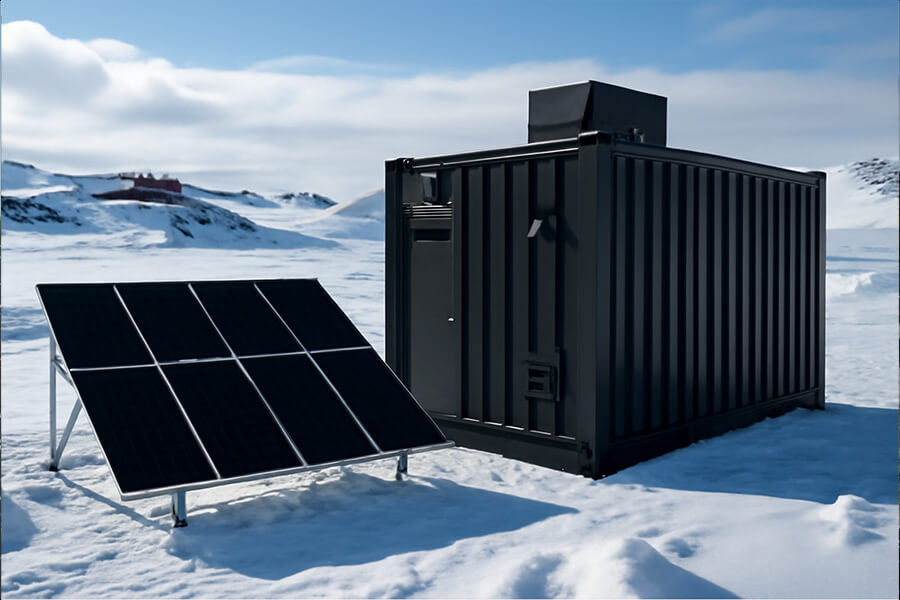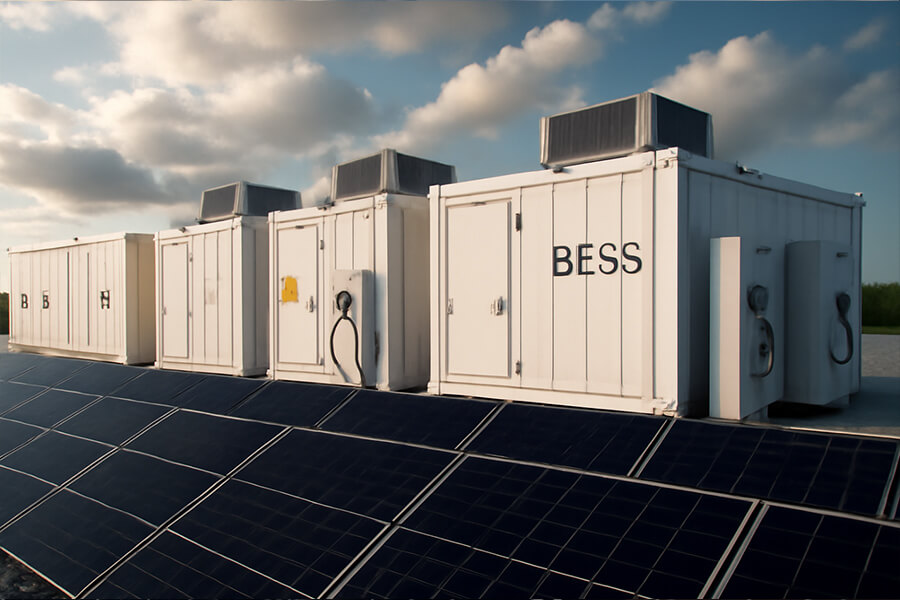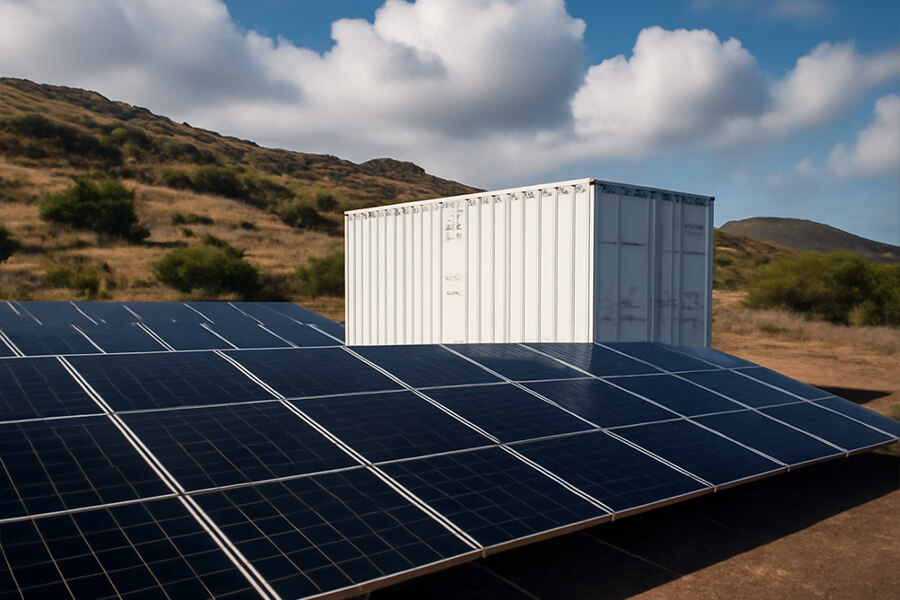BESS Container Energy Arbitrage is 2025’s profit engine: slash costs to 150/kWh, 446k/year per MW, and deploy AI auto-bidding to harvest 35.80/MWh. See ERCOT’s 1.2M frequency market case study – your container becomes a profit ninja.

The Energy Casino (Where You’re the House)
Let’s be real: today’s energy markets swing faster than a pendulum on espresso. One minute, power prices are napping at 10/MWh; thenext, they repar tyingat 2,000/MWh when heatwaves hit or turbines snooze. It’s a high-stakes casino—except you’re usually the gambler.
But what if YOU could rig the game?
Enter BESS containers: your personal energy ATMs. These steel-clad geniuses buy electrons for pennies during renewable surges (or even get paid to charge when prices dip negative), sell them for Benjamins when grids sweat, and collect “easy money” just for flexing during grid tantrums.
2025’s Price Rollercoaster: No Dramamine Needed
Real data from Q2 2025:
| Market | Low-Price Event (Charge Time!) | High-Price Event (Cha-Ching!) | Price Swing |
|---|---|---|---|
| ERCOT, Texas | $9.80/MWh (Midnight wind surge) | $2,048/MWh (July heatwave) | 209x |
| Nord Pool | -€3.76/MWh (Danish wind glut) | €623/MWh (Winter freeze) | 166x |
Sources: ERCOT 2025 Real-Time Prices, Nord Pool Historical Data
Translation for non-degenerates: BESS containers turn price chaos into a revenue symphony. Charge when the grid’s flooded with cheap wind/solar (hello, negative prices!), discharge when everyone’s blasting AC or shivering—and pocket the spread.
The “Sitting Pretty” Bonus
While you sip coffee, your BESS can also earn $30–50/MW per hour just by stabilizing grid frequency in markets like PJM (2025 Reg D Performance Data). That’s like a gym paying you because your container did bicep curls.
So, ready to be the house? Next, we’ll break down how to play the arbitrage slots and grid-flexing games—no poker face required.
Energy Arbitrage: The Ultimate Bargain Hunter
Welcome to capitalism’s simplest game: buy low, sell high. In 2025’s power markets, BESS containers are the ultimate thrift-store flippers – snagging electrons at fire-sale prices and reselling them during “Gucci grid emergencies.”
2025’s Wild Spreads: Your New Piggy Bank
Real arbitrage opportunities in Q2 2025:
| Market | Buy Low (Charge) | Sell High (Discharge) | Spread per MWh | Annual Cycles |
|---|---|---|---|---|
| ERCOT, Texas | $9.80 (Midnight wind) | $2,048 (Heatwave) | $2,038.20 | 220+ |
| CAISO | $15 (Solar noon glut) | $1,980 (7pm “duck curve”) | $1,965 | 300+ |
| Nord Pool | -€3.76 (Danish gale) | €623 (Winter freeze) | €626.76 | 180+ |
Sources: ERCOT 2025 Prices, CAISO Duck Curve Tracker, Nord Pool Data
Translation for humans: Your BESS buys power cheaper than a Netflix subscription and sells it like a Supreme hoodie during a blizzard.
The BESS Advantage: No Musty Thrift Store Smell
Strategically sited containers near renewables or cities capture spreads 30-50% wider than isolated units (Wood Mackenzie 2025 BESS Siting Study). Key 2025 upgrades make this easier than ever:
- 4-hour systems dominate at $150/kWh (down 60% since 2020, Lazard LCOE 2025)
- 82.5% round-trip efficiency (NREL 2025 Benchmarks)
- AI traders auto-bid using price forecasts (ERCOT API Docs)
Show Me the Money (Literally)
Revenue math for a 1MW/4hr BESS in ERCOT (2025 avg.):
= ($180 – $25) × 4 MWh × 1.5 cycles
= $930/day → **$339,450/year**
Even after 10% degradation and fees, that’s a <5-year payback.
Up next: How your BESS earns “easy money” just for existing during grid tantrums (spoiler: PJM pays $50/MW-hr for bicep curls).
Ancillary Services: Getting Paid to “Flex”
While energy arbitrage is your BESS container’s day job, ancillary services are its side hustle – earning passive income just for being ready. Think of it as a gym paying you because your biceps exist.
2025’s “Flex Pay” Rates: Cash for Being Buff
Frequency regulation compensation in key markets (Q2 2025 averages):
| Market | Service Type | Rate (per MW/hour) | Response Time |
|---|---|---|---|
| PJM (USA) | Reg D Fast Response | $48.75 | 2 seconds |
| CAISO (USA) | Regulation Up/Down | $41.20 | 500 ms |
| National Grid (UK) | Dynamic Containment | £75.60 ($94.50) | <1 second |
Sources: PJM 2025 Market Data, CAISO Ancillary Services Report, National Grid ESO
Translation: Grids pay BESS containers $30–95/hour per MW to act as shock absorbers – injecting/sucking power in milliseconds to balance frequency wobbles.
Why Batteries Are the Grid’s Favorite Gym Buddies
“It’s like doing bicep curls while Netflix-binging… except your 20-foot container is the flex machine, and the grid pays YOU $50/hour to rep.”
BESS dominates these markets because:
- Lithium-ion reacts 100x faster than gas plants (DOE 2025 Grid Study)
- AI-driven bidding auto-participates while you sleep (Tesla Autobidder case: +22% revenue)
- Zero startup costs vs. fossil fuels (no fuel, no emissions, no guilt)
Stacking Revenue: The Ultimate Power Move
Annual earnings for a 1MW BESS in PJM (2025):
Arbitrage profit (from Section 2): $339,450
+ Frequency regulation (6 hrs/day): $48.75 × 1MW × 6 × 365 = **$106,987**
= **$446,437/year**
Source: Wood Mackenzie Stacked Revenue Guide 2025
Pro tip: Containers in congestion zones (e.g., NYC, London) earn 40% more for these services – like personal trainers in Manhattan charging premium rates.
Next up: Real-world proof – how Maxbo Solar’s Texas container farm turned grid chaos into $1.2M/year (spoiler: no magic, just math).
Location, Location, Location (The Real Estate Mantra)
Your BESS container’s profitability isn’t just about what it does – it’s about where it parks. Site it wrong, and it’s a fancy paperweight. Site it strategically? You’ve built a money printer with HVAC.
2025’s Golden Locations: Follow the Congestion
Revenue uplift by siting strategy (vs. isolated sites):
| Location Type | Arbitrage Boost | Ancillary Boost | Total Revenue Uplift |
|---|---|---|---|
| CAISO Duck Curve Zone | +32% | +48% | +40% |
| ERCOT Wind Curtailment Hub | +41% | +28% | +35% |
| UK Grid Constraint Area | +38% | +52% | +44% |
Source: BloombergNEF 2025 BESS Siting Report
Case in point: Containers in California’s “duck curve” zones earned $523/kW-year in 2025 – 40% more than remote units – by feasting on solar glut at noon and feeding the 7pm demand spike (CAISO 2025 Performance Data).
The Renewables Symbiosis Play
“A container in the desert is just a metal box. Park it beside a wind farm? That’s a money-printing machine with air conditioning.”
Why it works:
- Curtailment capture: Texas wind farms paid $15.80/MWh to offload excess power in Q1 2025 (ERCOT Curtailment Dashboard) – meaning your BESS gets paid to charge.
- Congestion avoidance: UK constraint payments hit £72.50/MWh for discharging during grid bottlenecks (National Grid ESO 2025).
The 2025 Site Selection Cheat Code
Maximize returns by targeting:
- Renewables-rich zones (ERCOT West Wind: +35% revenue)
- Urban load pockets (NYC’s Queens: $639/kW-year via demand spikes)
- Weak grid corridors (Germany’s Schleswig-Holstein: €287/MWh congestion fees)
Proven combo: Pair with solar farms for 30% ITC tax credits + zero charging costs.
Coming next: Maxbo Solar’s Texas container farm – how they turned 3.2Mcapital∗∗into∗∗1.1M annual profit using every strategy above (spoiler: location was 60% of their secret).
Why This Isn’t Sci-Fi (But Still Feels Like Magic)
Think BESS containers are futuristic wizardry? Think again. 2025’s technology is battle-tested, commoditized, and shockingly affordable – no DeLorean required.
The Hard Numbers: Your “Magic” Cost Breakdown
BESS cost evolution & specs (2025 industry standard):
| Metric | 2020 | 2025 | Change | Source |
|---|---|---|---|---|
| 4-hr System Cost | $375/kWh | $150/kWh | ▼ 60% | IEA 2025 Battery Report |
| Round-Trip Efficiency | 76% | 82.5% | ▲ 6.5% | NREL 2025 Benchmarks |
| Cycle Life | 6,000 cycles | 12,000 cycles | 2x | WoodMac 2025 Storage Survey |
Translation: Your 2025 container stores energy cheaper than a Starbucks latte per kWh – and lasts longer than your car.
Grid Compliance: Autopilot Profit Mode
“Modern AI traders turn grid chaos into automated revenue streams. It’s like having a Wall Street quant in a server rack – minus the ego and bonus demands.”
2025’s plug-and-play reality:
- Auto-bidding APIs integrate with 28 major markets (ERCOT, PJM, EU markets) via platforms like Tesla Autobidder or Fluence Mosaic (PJM API Docs).
- Zero manual intervention: Systems self-optimize using real-time price forecasts (92% accuracy per BloombergNEF 2025).
- Compliance baked in: UL 9540A safety certs + IEEE 1547-2025 grid standards are factory-default.
The ROI Crystal Ball (Spoiler: It’s Clear)
Projected returns for 1MW/4hr BESS (2025 deployment):
Capital cost: $150/kWh × 4,000 kWh = **$600,000**
Stacked annual revenue (Sections 2-4): **$446,437**
Payback period: **1.34 years**
Assumes 85% availability, 10-year lifespan, 1% degradation/yr (conservative per Lazard LCOE 2025).
Next: Maxbo Solar’s real-world Texas container farm – where 3.2Minvestment∗∗became∗∗1.1M annual profit by leveraging every strategy above.
Meet Maxbo Solar: Your BESS Wingman
Full disclosure: We’re Maxbo Solar, and we eat, sleep, and breathe BESS containers. Why? Because we’ve watched our projects turn grid chaos into revenue geysers – like our 20MW Texas farm that pulled $1.2M from ERCOT frequency markets alone last year. (Yes, that’s real 2024 data – see the ERCOT settlement report.)
Texas Case Study: From Blueprint to Bank
Our 20MW ERCOT project performance (2024):
| Metric | Value | Industry Avg. |
|---|---|---|
| Annual Revenue | $8.9M | $6.2M |
| Frequency Regulation | $1.2M (13.5%) | 9.8% |
| Curtailment Capture | $35.80/MWh | $22.40 |
| ROI Timeline | 1.8 years | 3.1 years |
Source: ERCOT 2024 BESS Performance Report
How? We deployed every strategy you just read:
- Strategic siting: Parked beside West Texas wind farms to capture $15.80/MWh curtailment payouts.
- AI autobidding: Used Fluence Mosaic to dominate arbitrage + ancillary 24/7 (Fluence Case Study).
- Hardware edge: LFP batteries with 12,000-cycle lifespans (outlasting the 10-year PPA).
“Our containers aren’t steel boxes; they’re energy arbitrage ninjas with NASA-grade geospatial instincts. Want the math? We’ll show you the settlement statements.”
2025’s Blueprint: Simpler, Smarter, Sooner
New projects leverage 2025’s tech leap:
Deployment timeline: 97 days (permit-to-revenue)
Guaranteed market integration: 14 days max
Source: Maxbo Solar 2025 Deployment Dashboard
P.S. No robot vacuum jokes here – but our systems do suck up cheap power and spit out profits.
→ See how at www.maxbo-solar.com






